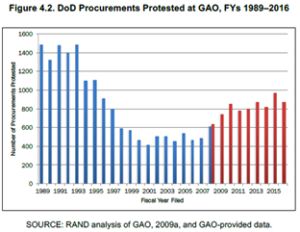Keywords: RAND, Government, NDAA, Procurement
The long-awaited study by the RAND Corporation (RAND) that was performed pursuant to Section 885 of the 2017 National Defense Authorization Act (NDAA) was delivered to Congress on December 21, 2017 and released to the public last week. Not only does RAND clearly explain with data the reasons for the Government's long-standing decision to have a robust bid protest system to review of agencies' procurement decisions, but RAND's data, analyses, and recommendations also undercut most of the incessant (and growing) calls for restrictions on bid protests. Among other things, the RAND report demonstrates that there is no basis for the "pilot program" of restrictions imposed by Section 827 of the 2018 NDAA—which requires payment of agencies' "costs incurred in processing" bid protests by large Government contractors in the event a challenge is not successful.
As RAND explained, the Government, "is a powerful entity in the economy," and has a "moral duty to maintain fairness in how it awards large contracts." The Government also needs to "deter and punish ineptitude, sloth, or corruption of public purchasing officials" (among other reasons for the bid protest system). For years, there have been complaints about the purported abuse of the bid protest process by contractors and unnecessary delays resulting from excessive bid protests. Although the officials calling for restrictions on bid protests were presumably able to present their best evidence and arguments to RAND's independent analysts, the empirical data simply does not support the restrictions sought. The annual complaints about bid protests in the run-up to each year's NDAA should cease—and Section 827 of the 2018 NDAA should be repealed.
RAND's report begins with a long explanation of the reasons for its study, the specific issues to be addressed, and the history of federal bid protest actions. It also provides a good explanation of why Congress has long believed bid protests are a necessary part of the federal procurement system.
Like many decisions made by executive branch officials that affect citizens' rights, people (and companies) whose interests are negatively affected by Government procurement actions (solicitations, awards) can challenge those decisions and have their rationality and legality reviewed under the standards set forth in the Administrative Procedure Act (APA). Not only is there no reason why federal procurement officials' actions should be immune from the APA review to which other federal officials' decisions are subjected, but RAND quoted GWU's Professor Kovacic to explain that bid protests are necessary to "accomplish nonefficiency goals that ordinarily are of little concern to private firms." Among other things:
Taxpayers typically want their government to deal fairly when it distributes money, judgments, and other "services" paid for by taxpayer money. Bid protests aim to ensure that government purchasing agents deal "fairly" with prospective suppliers.
To the extent possible, bid protests also provide assurance that Government funds are being distributed transparently and equitably—and that offerors are being given "an 'equivalent' chance" at winning contracts. In other words, bid protests help assure that contract awards are not tailored to a particular outcome and that taxpayers can be assured that their money is being spent transparently and efficiently. In this regard, protests provide oversight of purchasing agents who, unlike personnel in private companies, are not subject to compensation systems that provide strong incentives for improved performance. In addition, the bid protest system is supposed to "act as a signaling mechanism to potential private partners," which often must invest substantial sums to compete for Government work, that "if a decision is perceived to be unfair," the offeror can obtain review of the decision by "another party."
RAND's report is detailed and long, and describing all of its findings would be the subject of an article, not a blog post. We explain five important takeaways relevant to the arguments for restricting bid protests that have been made during the past several years.
1. Empirical data fails to support the FY 2018 NDAA's "pilot program" imposing costs on large contractors that lose bid protests. After considering other means to curtail contractors' ability to obtain meaningful (and timely) review of procurement decisions, Section 827 of the 2108 NDAA mandates that DoD "carry out a pilot project to determine the effectiveness of requiring contractors to reimburse [DoD] for costs incurred in processing covered protests." Section 827's pilot program will apply to large contractors, i.e., those "with revenues in excess of $250 [million]," when such firms' protests are "denied in an opinion issued by [GAO]." This provision does not take effect until October 1, 2019 (though GAO will have to determine many details before then)—which is ample time to repeal the provision that RAND's report demonstrates is completely unjustified.
DoD's desire, and Congress' decision, to focus initially on large contracts for this "losing-claimant pays" provision only makes sense if one believes that large firms are one of the primary problems in the bid protest system—and the problem that most urgently needs to be addressed. But RAND's data directly contradicts the notion that protests by large contractors are a problem.
Large contractors are not clogging up the Government's procurement system by filing a disproportionately large (or growing) numbers of bid protests. To the contrary, RAND's data shows that the protest activity of "the largest 11 [Government contracting] firms has remained relatively constant and may be slightly declining." What is more, "[t]he top 11 firms have higher effectiveness and sustained rates than the rest of the sample [though these rates are declining over time]—suggesting that they are possibly more selective in the protests they file and spend more resources developing their cases." In other words, higher percentages of the protests pursued by larger contractors have been found to be meritorious or have triggered corrective action by DoD agencies.
Although a loser-pays provision also is not appropriate with respect to small businesses, RAND's analysis of those companies' bid protests highlights the absurdity of Section 827's focus on larger contractors. One of RAND's "most striking" findings "is the fact that protests from small businesses account for more than half of all the protest actions." The ratio of small businesses' bid protests relative to the total number of protests is comparable to the percentage of DoD contracts going to small businesses, but the ratio of small business protests to total protests is "much higher than the fraction of DoD contract dollars going to small businesses." Given this, it is irrational to initiate a test program focusing on large contractors. The "loser pays" provision is unwarranted by any measure.
2. There is no support for claims of a problematic increase of "frivolous" protests. Advocates for restrictions on bid protests have voiced the a perception that the number of frivolous or extremely weak protests is growing. But the protesters' success rates flatly contradict this notion. RAND found that protesters' sustain rate (in which they prevailed after completion of the protest process and issuance of a decision) and the effectiveness rate (which refers to a protester receiving some relief, e.g., the agency takes corrective action prior to a GAO decision) has been stable over time. Indeed, "from FY 2008 to FY 2016, the effectiveness and sustain "rates have been steady and may be slightly increasing with time." "[T]he stability (or slight increase) in the effectiveness rate while the number of protests is increasing refutes the claim that meritless protests (some use the term frivolous) account for th[e] increase[ing]" number of protests.
During their history of reviewing these cases, GAO and the CFC have dismissed bid protests as "frivolous" only a small handful of times. To the extent agencies believe a bid protest fails to satisfy the requirements for an action, they can seek dismissal of purportedly frivolous filings. Absent evidence that frivolous bid protests are a problem facing the procurement system (and there is none), no modifications to GAO's jurisdiction or rules should be considered to address this non-issue.
3. Complaints about the recent increase in bid protest activity must be viewed in context. The RAND study recognizes that the bid protest "activity for both DoD and non-DoD agencies has approximately doubled" during the period "between FY 2008 and FY 2016." Notably, this increase in activity occurred after GAO was given jurisdiction to consider task order protests, though RAND asserted that "even excluding [such protests] the upward trend is still statistically significant."
But RAND correctly points out that the recent increase in protest activity should be considered in context in two respects. First, when the researchers "go back further in time" and analyze a data set that GAO provided, the picture looks very different:

As RAND's chart makes clear, "the time trend clearly shows that protest activity was much higher in the late 1980s and early 1990s than it is today." Second, RAND explains the importance of understanding "that the overall percentage of contracts protested is very small, less than 0.3 percent," and that this "small value implies that bid protests are exceedingly uncommon for DoD procurements."
4. There is no basis for reducing the time GAO has to consider a bid protest. Bid protests at GAO are (by statute) supposed to be—and almost always are—resolved within 100 days. Last year, legislative proposals were considered to reduce to 65 days the amount of time GAO has to resolve bid protests. The RAND report pointed out serious problems with this proposal, explaining that although "a large number of the protest actions are resolved within the 65-day window, those requiring decisions by GAO are not." The cases that go to decision "are typically more complex and as such are not simply resolved." RAND correctly explained that "shortening the window for GAO to close protests could result in an inadequate amount of time to develop the[ record in] these more complex" cases.
The RAND report points out another problem with the proposed shortening of GAO's time to consider bid protests. As a result of agencies' annual procurement cycle—and agencies making large numbers of important award decisions near the end of the fiscal year—GAO bid protest "filings peak around the end of the fiscal year then drop sharply in November, December, and January." The 100-day decision window "allow[s] GAO to smooth the workload between the peak and minimum filing periods (which are adjacent)." Reducing the time to consider protests "would provide less flexibility to GAO in managing its protest workload and may require additional staff to meet peak filing demand." These timing issues would have to be considered carefully to the extent reducing GAO's decision timeline is ever seriously explored. (Note: Although addressed by RAND, it is odd that some agencies complain about the 100 days given the schedule under which protests proceed. Protests are filed without access to the record (unlike other APA review proceedings), and agencies are given 30 days to produce the record, after which a supplemental protest based on the actual record must be filed within 10 days. One obvious solution to reducing the amount of time a protester has to prosecute its challenge or that GAO has to resolve the protest is to require agencies to produce the record earlier in the proceeding.)
5. There is no good reason to reduce contractors' ability to protest task orders awards. As noted above, GAO was given jurisdiction to consider protests of agency awards of task orders above certain financial thresholds. GAO's jurisdiction was expanded to include task orders in FY 2008, when Congress recognized that an increasing volume of contracting dollars was being spent under these procurement vehicles. Although there have subsequently been attempts to limit GAO's ability to consider challenges to task order awards, the RAND analysis explains that "task-order protests have slightly higher effectiveness and sustained rates compared with the rest of protests." The report reasonably concludes that "[t]his positive, though small, correlation suggests that restricting protests on task orders is not supported by the outcomes." Indeed, there is no good reason to restrict challenges to awards using this procurement vehicle as the volume of task order awards continues to increase.
Conclusion
In sum, the RAND report confirms that the current protest process strikes a reasonable balance between the Government's need to get it contracts awarded and protection of the public interest in the integrity and transparency of the acquisition process. Longstanding principles of review of agency decisions underlie the GAO protest process, and the advocates for deterring companies that use the process misapprehend the critical role of review of agency decisions in a democracy.
(The RAND study also produced a list of six recommendations for improving the bid protest process; those issues will be addressed in a later blog post.)
Visit us at mayerbrown.com
Mayer Brown is a global legal services provider comprising legal practices that are separate entities (the "Mayer Brown Practices"). The Mayer Brown Practices are: Mayer Brown LLP and Mayer Brown Europe – Brussels LLP, both limited liability partnerships established in Illinois USA; Mayer Brown International LLP, a limited liability partnership incorporated in England and Wales (authorized and regulated by the Solicitors Regulation Authority and registered in England and Wales number OC 303359); Mayer Brown, a SELAS established in France; Mayer Brown JSM, a Hong Kong partnership and its associated entities in Asia; and Tauil & Chequer Advogados, a Brazilian law partnership with which Mayer Brown is associated. "Mayer Brown" and the Mayer Brown logo are the trademarks of the Mayer Brown Practices in their respective jurisdictions.
© Copyright 2018. The Mayer Brown Practices. All rights reserved.
This Mayer Brown article provides information and comments on legal issues and developments of interest. The foregoing is not a comprehensive treatment of the subject matter covered and is not intended to provide legal advice. Readers should seek specific legal advice before taking any action with respect to the matters discussed herein.

